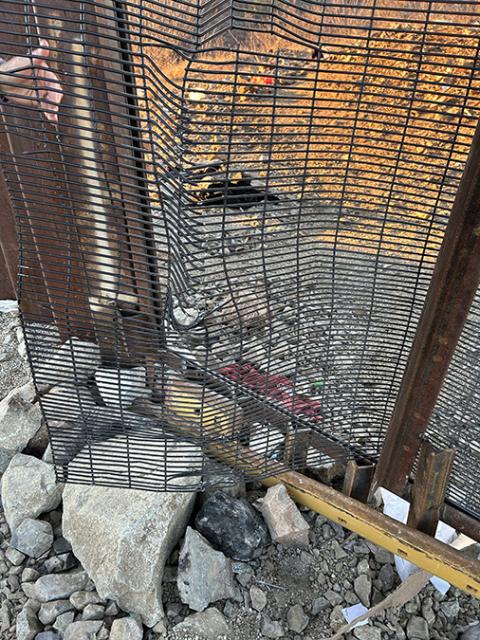
Sr. Judy Bourg (purple jacket) stands with asylum-seekers who entered the United States through an opening in the U.S.-Mexico border wall. Bourg welcomed each of them, then gathered them in a circle and said, "We are happy that you are here." To Bourg's left is Sr. Maria Louis Edwards. (Peter Tran)
Editor's note: Global Sisters Report launches a new series, "Welcoming the Stranger," which takes a closer look at women religious working with immigrants and migrants. The series will feature sisters and organizations networking to better serve those crossing borders, global migration trends and the topic of immigration in the upcoming U.S. presidential election.
It was a few minutes after 10 a.m. when a small group of about 15 asylum-seekers began to crawl through a small, twisted opening in a steel grate of the U.S.-Mexico border wall.
A mother with her two young children, one less than a year old, and the other about 5, feeling exhausted from the journey, found an empty milk crate and sat down. They set their few belongings aside, including the young girl's doll. An elderly woman with a walker also sat down on an empty milk crate, surrounded by her family of five or so adult children.
There were two unaccompanied minors, including a young teenage girl. A middle-aged woman said the young teenage girl was traveling with her even though they were not related.

Asylum-seekers crawled through this small, twisted opening in a steel grate fence of the U.S.-Mexico border wall. (Peter Tran)
Two young men, one from Guatemala and another from El Salvador, traveled together. After pulling themselves through the hole in the grate fence, they rushed to a sign that read: "Humanitarian Aid Is Never a Crime." They knelt and made a sign of the cross, with an incredulous look as if their presence on the United States soil was not real.
The volunteers of the Tucson Samaritans rushed to greet the asylees, as another group of about 40 people climbing up the hill on the Mexico side started pulling themselves through the hole in the grate fence. Another group, No More Deaths, had set up a tarp as a temporary shelter camp and placed empty milk crates for people to sit at the Holden opening, and another camp a few miles west, with various sizes of tents. In this long stretch of the border wall from Holden to Sasabe, a U.S. port of entry 15 miles west, volunteers for the three humanitarian groups, Tucson Samaritans, Green Valley-Sahuarita Samaritans, and No More Deaths have been working together to give food, water, blankets, and warm clothes to the border crossers.
It was in the high 40s, but the people were dressed warmly as they stood or sat with their families along the wall. After the excitement of the initial arrival into the U.S., children felt safe and began to play on the border road.
"Agua," one volunteer walked around and offered each a water bottle, while other volunteers offered apples, bread, "salchicha de Viena" (Vienna sausages), rosaries, and small toys for the 10-15 children. About 60 people altogether stood or sat along the wall — eating and drinking quietly.

Asylum-seekers standing at the U.S.-Mexico border wall (Peter Tran)
Sr. Judy Bourg of Tucson Samaritans walked around to greet and welcome each of them to the United States. The School Sister of Notre Dame then gathered them in a circle, and said, "We are happy that you are here."
"We are Tucson Samaritans," she said, explaining that they are a grassroots humanitarian aid group in southern Arizona whose members provide water, food, warm clothing, and first aid to migrants who cross the border from Mexico to the U.S. She told the arrivals that they were now standing in the United States. "The Border Patrol will be coming to take you to the processing center where you will receive the document that will attest to your legal status in the United States. Make copies of your parole papers when you arrive to your families or friends."
She told them it is important to have those identification papers with them whenever they leave their new homes and to attend the first court hearing date listed on their documents. She also introduced the four volunteers who accompanied her on this mid-January day, including a Felician sister and a Redemptorist priest.
I accompanied them on this recent trip in January as a freelance writer, along with a photojournalist. I had read about the surge of migrants seeking asylum in local and national media since the summer of 2023. I also heard about the increasing number of asylum-seekers from contacts working in border ministries — Tucson Samaritans, Casa Alitas, the Tucson Diocese's Catholic Community Services, and at the Kino Border Initiative, a Catholic migrant center in Nogales.
Advertisement
I also witnessed it as I have taken priests and sisters for an immersion migrant experience in the desert, at the wall, or at Casa Alitas or Kino. We would serve meals to migrants along the wall, or in the centers. We would hear tragic stories from the new arrivals. They would tell us that they were grateful for the conditions now — on the desert road, or in crowded shelters, which were better than the situations they had fled.
Seeing young families, elderly people and adults crawling through the gap of the twisted grate wall, entering the U.S. and presenting themselves to Border Patrol officers and asking for asylum at this recent outing with Bourg confirmed the desperation of these new arrivals. Regardless of their ordeals, they wanted badly to begin a new life.
Bourg also said she also volunteers at Casa Alitas, which offers shelter, necessities, and travel assistance to asylum-seekers. Many asylees go there for a short stay, after their release from Border Patrol. She said many times she encounters the people she met at the border wall at Casa Alitas. "It is a grand reacquainting."

A doll is pictured, belonging to a child who had just entered the U.S. with her family through a gap in the border wall. The child and her family sat down on an empty milk crate. They set their few belongings aside, including the doll. (Peter Tran)
In two or three days, she told them, many would be united with their husbands, wives, parents, siblings, children, uncles and aunts. When she made that comment she saw their "sweetest smiles." She added, "It fills my heart with warmth."
A few minutes later, a U.S. Border Patrol van arrived. Bourg instructed the volunteers to step aside on the other side of the road. A Border Patrol officer stepped down to see if anyone was injured or needed medical assistance. Soon other Border Patrol vehicles arrived. The agents began directing the people to get into the van. As the volunteers waved goodbyes, they saw smiling faces inside the vans waving back.
"It was a good day," said one of the volunteers, as they were able to welcome and feed the asylees. The day had started early for the volunteers as they left Tucson at 4:45 a.m. with a truck full of food, water, blankets, warm clothing, and medicine. They had traveled to the U.S.-Mexico border wall, about 10 miles south of Arivaca, which is about an hour from Tucson. Driving around various mountain peaks on a dangerously curved dirt road in the dark, they arrived at a shelter set up by No More Deaths, a nonprofit organization that provides emergency assistance to asylum-seekers or migrants.

The sun rises above the horizon along the U.S.-Mexico border wall. (Peter Tran)
As the sun began to rise, the Samaritan volunteers continued their journey to Holden Canyon where they waited for asylees to arrive. The day before, Bourg said, they had encountered about 160 people, a substantial number.
The Pima County Southwest Border Information said that the total number of asylum-seekers in 2023 through November was 195,558. That compares with 85,703 in 2022 and 18,131 in 2019. About 2.4 million migrants (a record) crossed the U.S.-Mexico border in fiscal year 2023, which ended in September.
Bourg, who still drops water for migrants for two days in the desert around Ajo each month, said that she usually goes to the border wall four days a week. "I want to spend as much time as possible to welcoming our new friends into this country because who knows what it is going to happen with the migration policy after this year's election," she said.
"In my 45 years as a religious, I have always focused on the value of the individual," she added. "We know that people have the right not to migrate to live with dignity in their own country. But they also have the right to migrate to seek a way to live a full life. We must honor that. In addition, I found myself a focal point of preparing food, cooking food, and sharing food with others so we can share with each other. Welcoming and sharing food with these new arrivals is what hospitality is about. Regardless of their nationalities, we are one human family. This is the value that I wish to share with them."





